When Russia went to sea, found its own fleet and overseas colonies - Russian America - it only had to go forward. It was hard to believe that until quite recently the Russian fleet, created by the will of Peter I, did not exist at all. And now the idea arises of a round-the-world trip, which would be made under the Russian naval flag.
predecessors
Under the phrase of the famous diplomat and traveler N.P. Rezanov “Let the fate of Russia be winged with sails!” Many people would sign - both commanders, and ordinary sailors, and those who, without going to sea themselves, did everything possible to carry out such expeditions. The great Transformer himself dreamed of long-distance sea voyages, Peter's plans included a trip to the West Indies, crossing the equator and establishing trade relations with the "Great Mughals".
These plans were not destined to come true. Nevertheless, in 1725-1726, a Russian ocean expedition to Spain took place under the command of Captain I. Koshelev, who later proposed the idea of a round-the-world trip from St. Petersburg.
In 1776, Catherine II signed a decree on sending ships from the Baltic Sea to the first Russian round-the-world expedition. The campaign was to be led by a young captain G.I. Mulovsky, an experienced and skilled sailor. The expedition had to solve several problems at once: to deliver fortress guns to the Peter and Paul harbor, to establish trade relations with Japan, to take cattle and seed grain, as well as other necessary goods to settlers in Russian America, and in addition, to discover new lands and strengthen the prestige of Russia.
Preparations for a large-scale expedition were in full swing, the factories had already cast iron coats of arms and medals with images of Catherine, which were to be installed in the newly discovered territories. But the Russian-Turkish war began, and all the supplies were ordered to be distributed to the ships going to the Mediterranean Sea. Mulovsky himself was killed in a naval battle. During the reign of Catherine the Russian circumnavigation never materialized, but the idea had already taken hold of the minds.
The first Russian round-the-world expedition
Sometimes life turns out so strangely that in any book such a plot would look like a stretch. On the ship "Mstislav" was a very young midshipman, yesterday's midshipman. Ivan Kruzenshtern was only 17 years old when he entered under the command of Captain Mulovsky. It is difficult to say whether they were talking about the failed expedition, but it was Kruzenshtern who had to do what fate denied his brave predecessor.
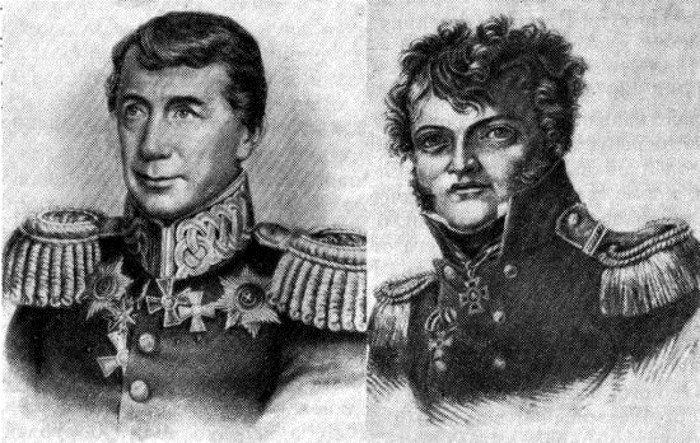
I. F. Kruzenshtern and Yu. F. Lisyansky
Ivan Fedorovich Kruzenshtern and his brother in the Naval Corps Yuri Fedorovich Lisyansky, as young sailors who showed significant success, were sent for training in the English fleet. Kruzenshtern became extremely interested in trade with China, visited Chinese ports - and upon returning to Russia, in detail, with figures and calculations, he expressed his opinion that the organization of maritime communications between Russian colonies and China was extremely beneficial and useful for Russia. Of course, the opinion of the young lieutenant was ignored - the proposal was too bold. But suddenly Kruzenshtern was supported by prominent and authoritative nobles - State Chancellor Rumyantsev and Admiral Mordvinov, and soon the Russian-American Company (RAC) made a similar proposal - and so the fate of the first Russian round-the-world expedition was decided.
The generous sponsorship of the RAC made it possible not to wait until ships were built that could withstand the hardships of the journey. Two suitable vessels were purchased in England, improved, named "Nadezhda" and "Neva". The RAC was powerful and wealthy enough to ensure that the expedition was supplied with the very best in record time.
Only volunteers were recruited for a long and dangerous journey - nevertheless, there were so many of them that it would be just right to complete three expeditions. The team included scientists, artists (to sketch landscapes, plants and animals unknown to science), an astronomer. The goal was to deliver the necessary goods to our Russian settlements in America, to take away their furs, to sell or exchange goods in Chinese ports, to prove the benefits of the sea route to Russian America compared to the land route through Siberia. And besides, to deliver an embassy to the shores of Japan under the leadership of chamberlain N. P. Rezanov.
Despite the "commercial" nature of the expedition, the ships sailed under the naval flag. Chamberlain Rezanov was far from the last person in the RAC, after all, the son-in-law of the head and founder of the company, G. Shelikhov, the heir to the capital of the "Russian Columbus". It was assumed that he was responsible for the scientific and economic part, and Kruzenshtern - for the sea. In August 1803, the Neva and Nadezhda set sail from Kronstadt. After the Hawaiian Islands, the ships, as agreed, dispersed. The Neva, under the direction of Lisyansky, sailed north to the islands of Kodiak and Sitka in the Gulf of Alaska, loaded with goods for the RAC, to rendezvous with the Nadezhda at Macao in September 1805. "Nadezhda" went to Kamchatka - and then - to Japan to fulfill Rezanov's diplomatic mission. On the way, Nadezhda got into a severe storm - and, as it turned out later, into a tsunami zone.
Alas, the mission was a failure - after almost six months of waiting in Nagasaki, the Russians were refused. The Japanese emperor returned gifts (huge framed mirrors), refused to accept the embassy and ordered to leave Japan immediately, however, he supplied the ship with water, food and firewood. In Macau, the captains met, exchanged furs for tea, porcelain and other rare and liquid goods in Europe, and set off for Russia. After the storm, having lost sight of each other, Nadezhda and Neva safely returned to Russia, first the Neva, then, a couple of weeks later, the Nadezhda.
Swimming did not proceed as serenely as we would like. Problems began almost immediately after sailing. Chamberlain Rezanov had a rescript signed by Alexander I, according to which he, Rezanov, was appointed head of the expedition, but with the proviso that all decisions be made jointly with Captain Kruzenshtern.
For the sake of accommodation on the relatively small "Nadezhda" of Rezanov's retinue, a number of people really needed in swimming had to be refused. In addition, Rezanov's retinue included, for example, Count Fyodor Tolstoy, later nicknamed the American, an absolutely uncontrollable, cruel manipulator and intriguer. He managed to quarrel with the whole team, more than once annoyed Krusenstern personally with his antics - and in the end he was forcibly landed on the island of Sitka.
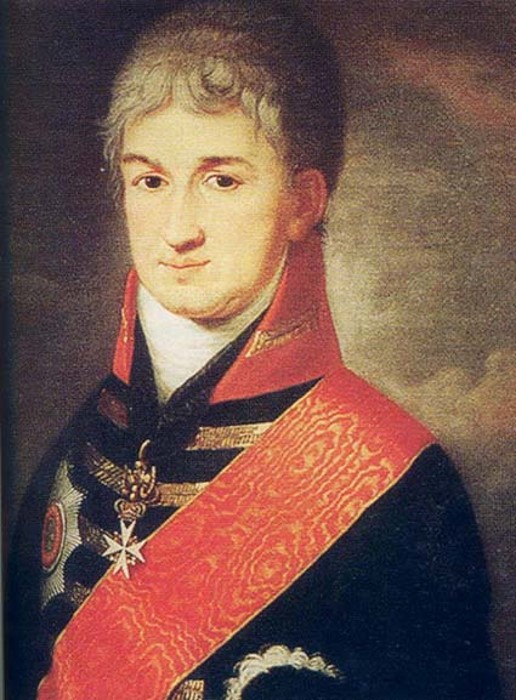
N. P. Rezanov
On a warship, according to the charter, there could be only one leader, whose orders are carried out unquestioningly. Rezanov, as a non-military man, did not accept discipline at all, and gradually relations between him and Krusenstern heated up to the limit. Forced to share one tiny cabin for a couple of years, Rezanov and Kruzenshtern communicated through notes.
Rezanov tried to force Kruzenshtern to change the route of the expedition in order to immediately go to Kamchatka - in fact, interrupting the trip around the world. Finally, Rezanov allowed himself to be rude towards the captain in the presence of the team - and this, from the point of view of the charter, was completely unforgivable. After a loud scandal, making sure that there was no one on his side, the offended Rezanov practically did not leave the cabin until the Nadezhda reached Petropavlovsk.
Fortunately, the experienced and cold-blooded commandant P. Koshelev sorted out the matter, regardless of the faces, trying to prevent a quarrel between two private individuals from interfering with the fulfillment of public duty. Kruzenshtern fully agreed with this, and Rezanov had to back down. At the end of the Japanese mission, Rezanov left Nadezhda - and he and Kruzenshtern did not meet again, to mutual satisfaction.
The further history of N.P. Rezanov, who went to California and met there the 14-year-old beauty Maria Concepción Arguello, the daughter of the commandant of San Francisco, is known as one of the most romantic pages not only in Russian, but probably in world history. The famous rock opera "Juno and Avos" tells about their tragic love, but this is a different, albeit very interesting, story.
Travel Kotzebue
Among the volunteers who went with Kruzenshtern on the Nadezhda was a 15-year-old cabin boy, German Otto Kotzebue. The boy's stepmother was the lieutenant commander's sister, Christina Kruzenshtern. When the Nadezhda returned to the port, Kotzebue was promoted to midshipman, and a year later - to lieutenant, and although he was not a graduate of the naval school, Otto Evstafievich received the best of the naval schools - the school of circumnavigation, and since then he has not thought of life without the sea and serving the Fatherland.
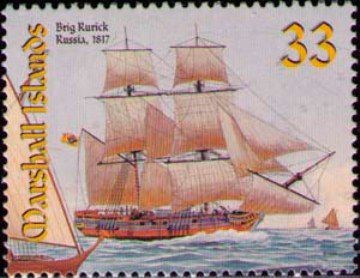
Brig "Rurik" on the stamp of the Marshall Islands
At the end of the circumnavigation, Kruzenshtern worked tirelessly on the results of the expedition, prepared reports, issued and commented on maps and the Atlas of the Southern Seas, and in particular, together with Count Rumyantsev, developed a new circumnavigation expedition. She was tasked with finding the Northeast Sea Passage from the Pacific to the Atlantic Ocean. The expedition was supposed to go on the Rurik brig. The command of the brig, on the recommendation of Krusenstern, was offered to Kotzebue.
This expedition returned after 3 years, having lost only one person and enriched geography with a mass of discoveries. The little-studied or generally unknown islands, archipelagos and coasts of the Pacific Ocean were drawn on the map and described in detail. Meteorological observations, studies of sea currents, ocean depths, temperature, salinity and transparency of water, terrestrial magnetism and various living organisms were an invaluable contribution to science - and had considerable practical benefits.
By the way, the German scientist and romantic poet A. von Shamisso, Pushkin's translator into German, took part in the voyage on the Rurik as a naturalist. His novel Journey Around the World became a classic of adventure literature in Germany, and it was also published in Russia.
O.E. Kotzebue made the third trip around the world in 1823–1826. Prior to that, for a year he guarded the shores of Russian America from pirates and smugglers with his 24-gun sloop "Enterprise". The scientific results of the expedition on the "Enterprise" were almost more significant than the results of sailing on the "Rurik". The physicist E. Lenz, the future academician who went with Kotzebue, designed, together with a colleague, Professor Parrot, a device called a bathometer for taking water samples from various depths, and a device for measuring depths. Lenz studied the vertical distribution of salinity, scrupulously noted the temperature of the Pacific waters and diurnal changes in air temperature at different latitudes.
By the 20s of the 19th century, traveling around the world had ceased to be something unimaginable and out of the ordinary. A number of glorious Russian captains circled the globe, leaving Kronstadt and heading towards the horizon.
Vasily Golovnin - unstoppable and fearless
Vasily Mikhailovich Golovnin, a captain and an excellent seascape writer, was considered a worldly-wise man even among his fellow captains. More than enough adventures fell to his lot. At the age of fourteen, as a midshipman, he participated in naval battles - and was awarded a medal, and then returned to finish his studies, as he was still too young to become an officer.
He made his first independent circumnavigation of the world when he was only a lieutenant. The Admiralty changed its own rules and transferred the Diana sloop under the command of a lieutenant, because everyone understood what kind of person Lieutenant Golovnin was. And indeed, their expectations were justified - an excellent captain, Golovnin fully possessed calmness, courage, and an unbending character. When, due to the outbreak of war, Russian sailors were detained by the British in South Africa, Golovnin managed to escape from captivity and nevertheless completed the mission assigned to the expedition. Round the world trip on the sloop "Diana" in 1808-1809. completed successfully.
The "gentleman's" captivity of the British was not too burdensome for our sailors, but the conclusion during the second trip turned out to be no laughing matter. This time Golovnin and a number of his comrades ended up in a real prison - to the Japanese. Those did not like the fact that the Russian ship carried out a cartographic survey of the Kuril Islands - in 1811 Golovnin was instructed to describe the Kuril, Shantar Islands and the coast of the Tatar Strait. Japan decided that impudent cartographers violate the principle of isolation of their state - and if so, then the place for criminals is in prison. The captivity lasted two years, because of this incident, Russia and Japan were balancing on a dangerous edge - a war between them was quite possible.

Japanese scroll depicting the capture of Golovnin
Herculean efforts were made to save Golovnin and his people. But only thanks to the actions of Golovnin's friend officer P.I. Rikord and the help of the influential Japanese merchant Mr. Takatai Kaheya, with whom Rikord managed to establish purely human contact, it was possible to accomplish the almost unbelievable - to return Russian sailors from a Japanese prison. On the territory of the natural park "Nalychevo" in Kamchatka there are so-called "peaks of Russian-Japanese friendship" - Kaheya rock, Mount Rikorda and Mount Golovnin. Today, the "Golovnin incident" is one of the textbook cases in the history of world diplomacy.
Golovnin's notes about his adventures were translated into many languages, and became a bestseller in Russia. Returning home, Vasily Golovnin continued to work tirelessly for the benefit of Russian navigation, his knowledge, experience, energy were invaluable, and many young men who later chose the career of a naval officer read Golovnin's books about distant wanderings.
Baron Wrangel - Head of Alaska
In 1816, midshipman Ferdinand Wrangel, who served in Revel, filed a petition to participate in the expedition of Captain Golovnin on the sloop Kamchatka. The youth was refused. Then, having told his superiors that he was sick, he reached St. Petersburg and practically fell at the feet of Golovnin, asking him to take him with him. He strictly noted that unauthorized flight from the ship is desertion and worthy of judgment. The midshipman agreed, but asked to be put on trial after the voyage, on which he was ready to become at least a simple sailor. Golovnin waved his hand and surrendered.
This was the first round-the-world trip of Ferdinand Petrovich Wrangel, after whom the now-famous reserve, Wrangel Island, was later named. On board the Kamchatka, the desperate young man went through not only a maritime school, but also diligently filled in the gaps in his education, and also found true friends - future explorers and tireless travelers Fyodor Litke and yesterday's lyceum student, Pushkin's friend Fyodor Matyushkin.
Traveling on the Kamchatka turned out to be an invaluable forge of personnel for the Russian fleet. Wrangel returned from a voyage as an excellent sailor - and a scientific researcher. It was Wrangel and Matyushkin who were ordered to go on an expedition to explore the northeastern coast of Siberia.
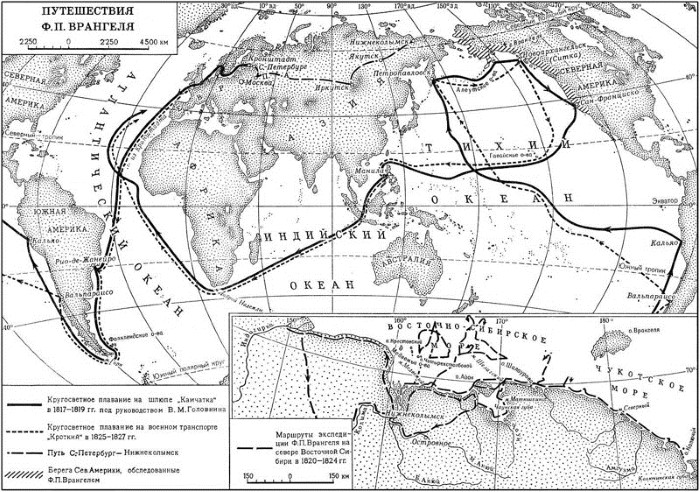
Map showing Wrangel's travel routes
Few people gave so much effort and energy to the study of Alaska and Kamchatka as Ferdinand Petrovich Wrangel. He explored North-Eastern Siberia from the sea and from land, went on a circumnavigation, commanding the Krotkiy military transport, was awarded orders, and in 1829 was appointed chief manager of Russian America, and, among other things, built a magnetic meteorological observatory in Alaska . Under his leadership, Russian America flourished, new settlements were created. The island is named after him, his works for the benefit of Russia were highly appreciated by the state and history. Less than fifty years have passed since the end of the first round-the-world voyage of Kruzenshtern and Lisyansky, and the Russian fleet flourished and developed rapidly - there were so many enthusiasts, truly devoted to their work, there were in its ranks.
Land unknown
“I went around the ocean of the Southern Hemisphere at high latitudes and did it in such a way that I undeniably rejected the possibility of the existence of a continent, which, if it can be found, is only near the pole, in places inaccessible to navigation ... The risk associated with swimming in these unexplored and ice-covered seas in search of the southern mainland, is so great that I can safely say that not a single person will ever dare to penetrate south further than I did., - these words of James Cook, the star of navigation of the XVIII century, closed the Antarctic research for almost 50 years. There were simply no people willing to finance projects that were obviously doomed to failure, and in case of success, they were still commercial failures.
It was the Russians who went against common sense and worldly logic. Kruzenshtern, Kotzebue and polar explorer G. Sarychev developed an expedition and presented it to Emperor Alexander. He unexpectedly agreed.
The main task of the expedition was defined as purely scientific: "discoveries in the possible vicinity of the Antarctic Pole" with the aim of "acquisition of the most complete knowledge about our globe". The expedition was charged with duties and was instructed by the instruction to mark and study everything worthy of attention, "not only related to maritime art, but generally serving to spread human knowledge in all parts".
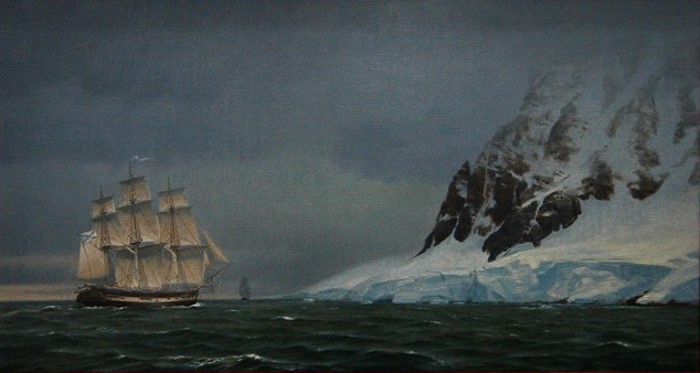
V. Volkov. Discovery of Antarctica by the sloops Vostok and Mirny, 2008
In the summer of the same year, the Mirny sloop and the transport, converted into a sloop, the Vostok, set out towards the South Pole. They were led by two captains who were considered among the best in the Russian fleet - the expedition commander Faddey Faddeevich Bellingshausen, a participant in the round-the-world trip of Kruzenshtern and Lisyansky, and Mikhail Petrovich Lazarev, a young but very promising captain. Subsequently, Lazarev will make three round-the-world trips, but these feats will not overshadow his fame as a polar explorer.
The voyage lasted 751 days, of which 535 days in the Southern Hemisphere, with 100 days in the ice. The sailors went beyond the Antarctic Circle six times. No one has approached the mysterious Antarctica so close and for so long. In February 1820, Bellingshausen wrote: “Here, behind the ice fields of small ice and islands, a mainland of ice is visible, the edges of which are broken off perpendicularly, and which continued as far as we could see, rising to the south, like a coast. Flat ice islands located near this mainland clearly show that they are fragments of this mainland, because they have edges and an upper surface similar to the mainland.. For the first time in the history of mankind, people saw Antarctica. And these people were our Russian sailors.
